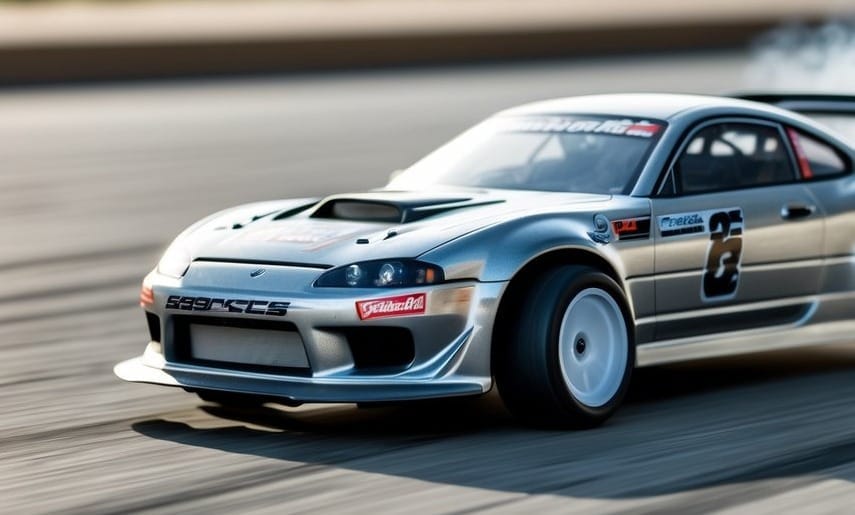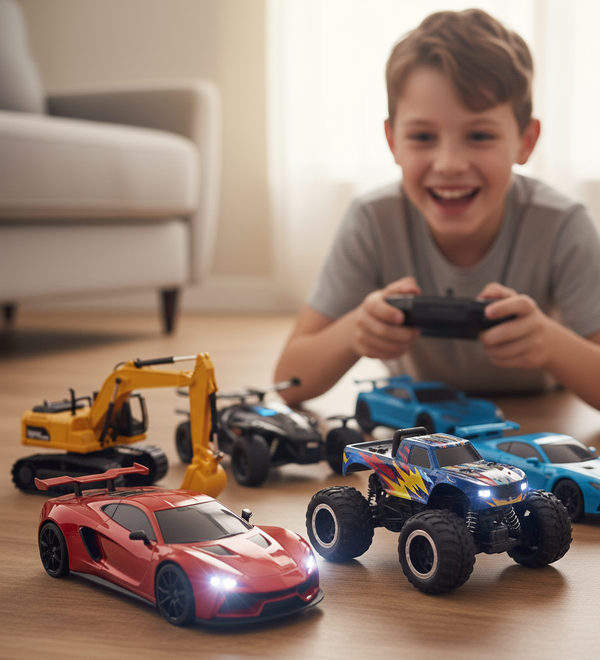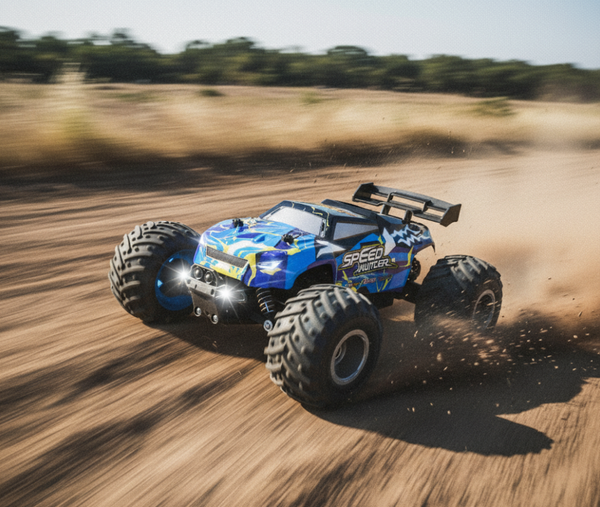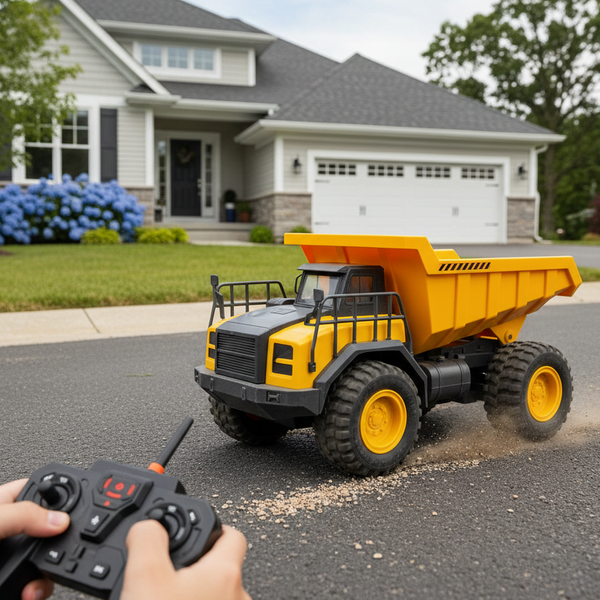Remote Control Drift Cars: Complete Guide to Top Amazon Picks & Buying Advice
Complete Amazon RC drift car guide: scales 1:43–1:10, prices $20–$300+, electric vs gas, RWD vs 4WD, brushless motors, LiPo batteries, adjustable suspension, gyro assists, on‑road/off‑road, RTR vs kits, maintenance, tuning, and how to spot value in reviews.

Remote control drift cars have become one of the most exciting categories on Amazon, offering everything from budget-friendly options under $30 to professional-grade models exceeding $200. These specialized RC vehicles are designed specifically for sideways action, featuring unique tires and suspension systems that let you perform controlled slides and turns just like real drift racing.

Amazon offers RC drift cars in multiple scales from 1:43 mini models to 1:10 professional builds, with prices ranging from $20 to over $300 depending on features like gyroscopes, brushless motors, and build quality. The platform makes it easy to compare different brands and read real customer reviews before making a purchase.
I've researched the current market to help you understand what separates a good drift car from a great one. From understanding the different types available to identifying key performance features, you'll learn how to choose the perfect RC drift car that matches your skill level and budget.
Types of Remote Control Drift Cars on Amazon
Amazon offers several distinct types of drift RC cars, each with unique power systems and drive configurations. The main categories include electric and gas-powered models, with different wheel drive systems designed for various surfaces and skill levels.
Electric Drift RC Cars
Electric drift cars dominate Amazon's selection due to their ease of use and maintenance. These models run on rechargeable batteries and offer instant throttle response.
Most electric drift RC cars on Amazon come ready-to-run with everything included. I find these perfect for beginners since they require minimal setup.
Key advantages of electric models:
- No fuel mixing required
- Quieter operation
- Clean performance
- Lower ongoing costs
Battery life typically ranges from 15-30 minutes per charge. Many Amazon listings include multiple batteries to extend driving time.
Popular electric options feature brushed or brushless motors. Brushless motors provide more power and longer lifespan but cost more upfront.
Gas-Powered Drift Cars
Gas-powered drift cars use nitro fuel or gasoline engines for extended runtime. These models appeal to experienced hobbyists seeking realistic engine sounds and longer driving sessions.
Gas-powered remote control cars require more maintenance than electric versions. I recommend these only for dedicated enthusiasts willing to learn engine tuning.
Gas-powered features:
- 20-45 minute runtime per tank
- Realistic engine noise
- Higher top speeds
- More complex maintenance
Fuel costs add up over time. These cars also produce exhaust and require proper ventilation during indoor use.
Amazon offers fewer gas-powered drift options compared to electric models. Most require additional purchases like fuel, glow plugs, and starting equipment.
4WD vs RWD Drift Cars
The drive system significantly affects drifting performance and handling characteristics. Both 4WD and RWD configurations have distinct advantages for different driving styles.
RWD (Rear-Wheel Drive) cars:
- More authentic drifting feel
- Easier to initiate slides
- Better for advanced techniques
- Require more skill to control
RWD models closely mimic real drift cars. The rear wheels provide power while front wheels steer, creating natural drift dynamics.
4WD (Four-Wheel Drive) cars:
- More stable and forgiving
- Better traction on various surfaces
- Easier for beginners
- Less realistic drift behavior
Many 4WD drift RC cars on Amazon feature adjustable torque split. This allows customization between front and rear power distribution.
I suggest RWD for experienced drivers wanting realistic drifting. Choose 4WD for easier handling and versatility.
On-Road and Off-Road Models
Amazon stocks drift cars designed for different surface types. On-road models excel on smooth pavement while off-road versions handle rough terrain.
On-road drift cars feature:
- Low ground clearance
- Hard plastic drift tires
- Lightweight construction
- Smooth surface optimization
These cars work best on concrete, asphalt, or indoor smooth floors. The specialized drift tires have minimal tread for controlled sliding.
Off-road capable models include:
- Higher ground clearance
- Knobby or all-terrain tires
- Reinforced chassis
- Better shock absorption
Off-road drift cars handle grass, dirt, and uneven surfaces. They sacrifice some drift precision for versatility and durability.
Most Amazon drift cars target on-road use. Off-road options cost more but provide greater flexibility in driving locations.
Key Features to Consider for RC Drift Cars

The motor type determines your car's performance and throttle control. Modern rechargeable batteries provide longer run times and better power delivery than older battery types.
Motors and Drive Systems
I recommend looking at the drivetrain configuration as your first priority. RWD cars offer more realistic drifting dynamics but require more skill to control.
RWD vs AWD Comparison:
- RWD: Better for experienced drivers, more precise drift angles
- AWD: Easier for beginners, more forgiving handling
Brushless motors provide smoother throttle response and longer lifespan compared to brushed motors. They cost more upfront but offer better performance for serious drifting.
Brushed motors work well for entry-level cars. They're cheaper and easier to maintain but lack the precision of brushless systems.
Battery Technology and Charging
Rechargeable lithium polymer (LiPo) batteries deliver consistent power throughout your driving session. They're lighter than NiMH batteries and provide better performance.
Battery Features I Look For:
- 7.4V or higher voltage rating
- At least 2000mAh capacity
- Included balance charger
- Multiple battery packs for extended play
NiMH batteries are safer for beginners but heavier and less powerful. They work fine for casual drifting sessions.
Charging time matters when you want continuous action. Fast chargers reduce downtime between driving sessions.
Suspension and Handling
Adjustable suspension lets you fine-tune your car's drift characteristics. Oil-filled shocks provide smoother performance than basic plastic dampers.
Key Suspension Adjustments:
- Camber: Controls tire contact patch
- Toe: Affects straight-line stability
- Ride height: Changes center of gravity
Wide steering angles of 45 degrees or more allow for sharper turns and better countersteering during drifting maneuvers.
A low center of gravity reduces body roll during cornering. Look for cars with mid or rear motor placement for optimal weight distribution.
Build Quality and Materials
The materials and construction quality of remote control drift cars available on Amazon directly impact performance, durability, and value. Key components like chassis strength, body shell design, and tire composition determine how well these cars handle drifting maneuvers and resist damage from crashes.
Chassis and Structural Components
I've found that the best remote control cars feature metal frames and aluminum components for superior durability. High-quality materials like metal frames and aluminum wheels provide better crash resistance compared to all-plastic construction.
Four-wheel drive systems offer stronger power delivery and improved control during high-speed drifting. The drivetrain components need robust gearing to handle the stress of constant sliding and direction changes.
Suspension systems vary significantly between models. Adjustable suspension allows fine-tuning for different surfaces and driving styles. Weight distribution plays a critical role in drift performance, with many cars featuring adjustable weight placement.
Battery compartments should be easily accessible and well-protected. Quality models include secure mounting systems that prevent battery movement during aggressive maneuvers.
Body Shells and Design Details
Polycarbonate body shells offer the best balance of flexibility and impact resistance. These shells can flex during impacts without cracking, unlike brittle plastic alternatives.
Many Amazon drift cars include LED lighting systems that enhance visual appeal during operation. Cool lighting features add realism but shouldn't compromise structural integrity.
Paint quality and finish vary widely between manufacturers. Higher-end models feature multiple color layers and clear coat protection. Budget options may have thinner paint that chips easily.
Body mounting systems should be secure yet allow easy shell removal for maintenance. Look for cars with multiple mounting points and quality body clips.
Tires and Traction Materials
Drift car tires differ significantly from standard RC car tires. Softer compounds provide controlled sliding while maintaining some grip for directional control.
I've tested various tire materials including hard plastic, soft plastic, rubber, and foam options. Each material affects drift characteristics differently:
- Hard plastic: Less grip, more sliding
- Soft plastic/rubber: Better control, moderate drift
- Foam: Good grip but faster wear
Tire compound directly impacts battery life since harder tires require less motor power. Tire width and tread pattern also influence drift behavior and surface compatibility.
Quality drift cars include multiple tire sets or offer easy tire changes. This allows customization for different surfaces and driving preferences.
Maximizing Performance and Drifting Skills
Getting the most from your RC drift car requires proper tuning, regular maintenance, and smart battery management. These three areas work together to keep your car performing at its best during every drifting session.
Fine-Tuning and Customization
I recommend starting with tire selection since this affects drifting more than any other part. Hard plastic tires give less grip for easier sliding. Soft rubber tires provide more control but make drifting harder to start.
Weight distribution plays a huge role in drift performance. I add small weights to the rear of my car to help initiate slides. Moving weight forward gives me better control during turns.
Suspension settings need adjustment based on your driving surface. Stiffer suspension works better on smooth floors. Softer settings help on rough surfaces like concrete or asphalt.
Motor upgrades can boost speed and acceleration. I focus on customizing remote control drift cars with better motors when stock performance feels limiting.
Gyro systems prevent unwanted spinning during drifts. These electronic helpers keep your car stable when you need precision control.
Maintenance Best Practices
I clean my drift car after every few sessions to prevent dirt buildup. Dust and debris affect motor performance and can damage moving parts.
Gear inspection should happen weekly. I check for worn teeth or loose connections that could cause power loss during drifting.
Wheel bearings need regular cleaning and light oil application. Smooth-rolling wheels improve battery life and overall performance.
I replace worn tires before they affect handling. Uneven tire wear changes how the car drifts and makes control harder.
Electronic connections require checking for loose wires or corroded contacts. Poor connections cause random power cuts during driving.
Motor brushes wear down over time in brushed motors. I replace them when I notice reduced power or sparking.
Battery Care and Longevity
Rechargeable batteries need proper charging cycles to last longer. I never leave batteries plugged in after they finish charging.
Storage voltage matters for battery health. I store my batteries at about 50% charge when not using them for more than a week.
Temperature affects battery performance during drifting sessions. Cold batteries provide less power and shorter run times.
I use a quality charger designed for my battery type. Cheap chargers can damage cells and create safety risks.
Discharge protection prevents over-draining during long drift sessions. Many modern RC cars have built-in low voltage cutoffs.
Multiple battery packs let me drift longer without waiting for charges. I rotate between two or three packs during practice sessions.
Battery balancing keeps all cells at equal voltage levels. This prevents early failure and maintains consistent power output.
Choosing the Best Remote Control Drift Car on Amazon

The right drift car depends on your experience level and whether you want something ready to drive or prefer building from a kit. Price and customer feedback help identify the best value options.
Suitability for Different Skill Levels
Beginner drift cars need simple controls and durable parts that handle crashes well. I recommend looking for cars with 2.4GHz remote control technology since they offer reliable connection without interference.
New drivers should focus on cars with ready-to-run features that include everything needed to start. These models typically have slower top speeds around 10-15 mph.
Key beginner features:
- Four-wheel drive for better stability
- Lower center of gravity
- Included batteries and charger
- Simple two-channel remote
Advanced users can handle faster speeds and more complex controls. These cars often reach 25+ mph and feature adjustable suspension settings.
Expert-level models offer customizable drift angles and professional-grade electronics. They require more maintenance but deliver realistic drifting performance that matches real race cars.
Ready-to-Run vs Kit Options
Ready-to-run (RTR) cars arrive completely assembled with everything needed to drive immediately. I find these perfect for beginners who want instant fun without tools or assembly time.
RTR advantages:
- No building required
- Includes remote, battery, and charger
- Factory-tested electronics
- Immediate driving satisfaction
Kit options require assembly but cost less and teach valuable skills. You'll need basic tools and 2-4 hours for most builds.
Kit benefits:
- Lower initial cost
- Learn car mechanics
- Customize during assembly
- Better understanding of repairs
Amazon's RC drift car selection includes both types with clear descriptions of what's included in each package.
Evaluating Value and User Reviews
I always check verified purchase reviews before buying any remote control cars on Amazon. Look for comments about durability, speed accuracy, and customer service experiences.
Red flags in reviews:
- Multiple mentions of broken parts
- Poor battery life under 15 minutes
- Unreliable remote connection
- Missing parts or accessories
Pay attention to photos in reviews showing actual cars and damage patterns. These give honest insights into long-term performance.
Price comparison helps identify fair deals. Budget models cost $30-60 while professional options range $100-200+. Mid-range cars around $70-90 often provide the best balance of features and quality.
Check return policies and warranty coverage. Reputable sellers offer at least 30-day returns and responsive customer support for technical issues.





